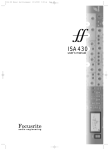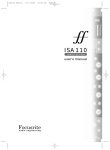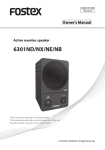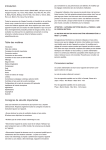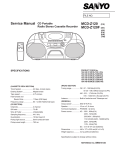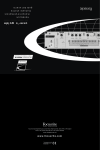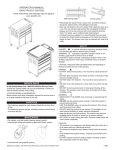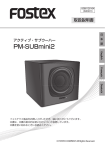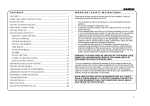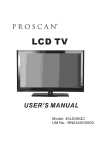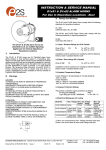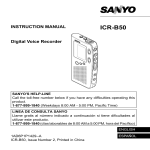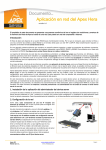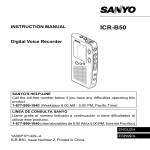Download ISA 430 MKII User Guide
Transcript
Introduction Important Safety Instructions Thank you for purchasing the ISA 430 MKII brought to you by the Focusrite team – Ian, Trevor, Peter, Martin, Tom, Mick A’C, Phil, Chris G, Micky, Pauline, Melissa, Chris W, Rob J Snr, Simon J, Vernon, Giles, Rob J Jnr, Mick G, Tim, Dave, Paul and Simon. Please read all of these instructions and save them for future reference. Follow all warnings and instructions marked on the unit. The chaps at Focusrite are a jolly hard working bunch and take a great deal of pride in designing, building and delivering products which are considered to be the best audio units around; we hope your new Focusrite unit lives up to that reputation and that you enjoy many years of productive recording. If you would like to tell us about your recording experiences, please email us at: [email protected] The Focusrite Team Contents Introduction....................................................................................... 1 Contents............................................................................................. 1 Important Safety Instructions ........................................................ 1 Power Connections ......................................................................... 1 Rear Panel Connections.................................................................. 2 ISA 430 MKII Front Panel Controls ............................................. 3 Metering.............................................................................................. 3 Input Stage.......................................................................................... 4 EQ Module......................................................................................... 5 Compressor....................................................................................... 6 Gate ..................................................................................................... 8 De-Esser ............................................................................................. 9 Output ................................................................................................ 9 Inserts and Routing Matrix...........................................................10 Soft Limiter ......................................................................................13 Optional Analogue to Digital Converter (ADC) ....................13 Digital Output Front Panel Controls.........................................14 ADC Configurations......................................................................15 Mic Pre-amp Input Impedance.....................................................16 Applications......................................................................................17 FAQs .................................................................................................21 Specifications ...................................................................................24 Accuracy ...........................................................................................26 Copyright..........................................................................................26 Warranty ..........................................................................................26 Reset Sheet ......................................................................................27 Focusrite Distributors...................................................................28 • Do not obstruct air vents in the rear panel. Do not insert objects through any apertures. • Do not use a damaged or frayed power cord. • Unplug the unit before cleaning. Clean with a damp cloth only. Do not spill liquid on the unit. • Unplug the unit and refer servicing to qualified service personnel under the following conditions: if the power cord or plug is damaged; if liquid has entered the unit; if the unit has been dropped or the case damaged; if the unit does not operate normally or exhibits a distinct change in performance. Adjust only those controls that are covered by the operating instructions. • Do not defeat the safety purpose of the polarised or grounding type plug. A polarised plug has two blades with one wider than the other. A grounding type plug has two blades and a third grounding prong. The wider blade or the third prong are provided for your safety. When the plug provided does not fit into your outlet, consult an electrician for replacement of the obsolete outlet. WARNING: THIS UNIT MUST BE EARTHED BY THE POWER CORD. UNDER NO CIRCUMSTANCES SHOULD THE MAINS EARTH BE DISCONNECTED FROM THE MAINS LEAD. This unit is capable of operating over a range of mains voltages as marked on the rear panel. Ensure correct mains voltage setting and correct fuse before connecting mains supply. Do not change mains voltage settings while mains supply is connected. To avoid the risk of fire, replace the mains fuse only with the correct value fuse, as marked on the rear panel. The internal power supply unit contains no user serviceable parts. Refer all servicing to a qualified service engineer, through the appropriate Focusrite dealer. Power Connections There is an IEC mains lead supplied with the unit which should have the correct moulded plug for your country. The wiring colour code used is: For units shipped to the USA, Canada, Taiwan and Japan: Live - Black Neutral - White Earth - Green For units shipped to any other country: Live - Brown Neutral - Blue Earth - Green and Yellow 1 Rear Panel Connections (Optional A/D Card shown fitted) XLR (Audio) Inputs and Outputs INSERT SEND 2 All 3-pin XLR audio connectors (main and post-mic outputs, mic, line & ADC inputs, insert sends & returns) are wired as follows: Pin 1 Screen/chassis Pin 2 Audio 0° Pin 3 Audio 180° This is used as the insert 2 output point, or as the analogue output from the dynamics module in ‘Dyn Split mode’ (see ‘Dynamics Split’ diagram on page 10). POST-MIC OUTPUT This is used as an output from the point immediately after the Phase section (i.e. before EQ and dynamics modules) allowing direct recording of mic, line or instrument inputs. It provides a direct-to-tape, ultra-short signal path output. Taking a signal from the POST-MIC OUTPUT does NOT interrupt a signal routed from the mic-pre to the EQ, dynamics etc., so a direct feed to tape can be achieved whilst simultaneously allowing processing of the same source. INST. HI Z INPUT 1/4” jack wired as follows: Tip Audio 0° Sleeve Screen/chassis KEY INPUTS 1/4” jack wired as follows: Tip Audio 0° Ring Audio 180° Sleeve Screen/chassis ADC INPUT 1 ADC Input 1 is used to route an external signal directly to the optional A/D card via the limiter. When selected using the ADC Input 1 button on the front panel, ADC Input 1 replaces the internal processed signal being fed to the left side of the A/D card (i.e. whatever is connected to the mic, line or instrument input no longer routes to the ADC). For further detail see ADC Input 1 & 2 on page 13. It also allows a signal to be summed with the processed signal from the unit by pressing the Ext Sum switch and using the Ext Level controls. This signal can be routed to the A/D card and main output (See ADC Input 1 & 2 on page 13.) DYNAMIC LINK 1/4” jack wired as follows: Tip Compressor sidechain link Ring Gate sidechain link Sleeve Screen/chassis MIC/LINE/INST INPUT Any one of these inputs may be used as the main input to the ISA 430 MKII’s main input. Signals routed to these inputs are referred to as the ‘Internal’ or ‘Int’ signal path. ADC INPUT 2 This is used as the insert 1 output point, or as the analogue output from the EQ module in ‘EQ Split mode’ (see ‘EQ Split’ diagram on page 10). ADC Input 2 is also used to route an external signal directly to the optional A/D card via the limiter. When selected using the ADC Input 2 button on the front panel, ADC Input 2 replaces the internal unprocessed signal being fed to the right side of the A/D card (i.e. whatever is connected to the mic, line or instrument input). This still allows the processed signal (i.e. whatever is connected to the mic, line or instrument input) to route to the left side of the A/D card. Hence there are four possible setups for the ADC 1 & 2 input switches. (See ADC Input 1 & 2 on page 13.) INSERT RETURN 2 MAIN OUTPUT This is used as the insert 2 input point, or as the input to the dynamics modules in ‘Dyn Split mode’ (see ‘Dynamics Split’ diagram on page 10). This output is used as the main analogue internal signal output, and is fed by whatever is connected to the MIC INPUT, LINE INPUT or INST INPUT, after this signal has been routed through the processing modules. INSERT RETURN 1 This is used as the insert 1 input point, or as the input to the EQ modules in ‘EQ Split mode’ (see ‘EQ Split’ diagram on page 10). INSERT SEND 1 2 gates to maximum (fully clockwise). The second unit will then act as ‘master’, allowing one set of parameter changes to affect both compressors or gates identically. NB: The deessers are not linked. DYNAMIC LINK You can connect two ISA 430 MKII units (using a standard TRS 1/4” jack-to-jack lead between the DYNAMIC LINK sockets) to allow both the compressor and gate sections to behave as stereo pairs of processors. When connected in this way, the compressors and gates behave as single stereo devices. Both units respond to the higher of the two input signal path levels. (The EQ channels can be matched visually or aurally to be used as a stereo pair if required.) Hence, to drive the compressors and gates as stereo pairs, set the threshold pot of one of the compressors and one of the Retrofitting the Optional A/D Card The optional A/D card can be retrofitted to a standard ISA 430 MKII at any time. Full fitting instructions for this option are included with the Card. ISA 430 MKII Front Panel Controls VU meter when the Listen switches are pressed in the compresser, gate or de-esser sections. The Listen LED will also light when any of these switches are selected. Power Applies power to the unit. Turn on the ISA 430 MKII before powering up devices to which the outputs are connected. Meter 0VU Calibration Inst Input The metering calibration for the input level and insert return levels can be shown over two different ranges: Unbalanced instrument sources may either be connected via the rear panel INST. HI Z INPUT, or via this duplicated front panel jack. If both are connected, the front connection overrides the rear connection. No DI box is required. • • Metering 0VU corresponds to +4dBu. 0VU corresponds to +18dBu. Either can be selected via the Meter 0VU Calibration button. For the compressor, the meter indicates the amount of gain reduction applied, from 0VU (no compression) to -20VU (corresponding to 20dB of gain reduction). NB: The effect upon ‘Listen’ of calibration is similar to that on input and insert returns. However, as the signal being monitored by the listen circuit is a sidechain source, the meter acts more as a visual indication of the attack and decay of a signal, rather than true level. Listen LED This illuminates when Listen is selected on the compressor, expander/gate or de-esser, and indicates that the unit is monitoring the selected sidechain frequencies. N.B. When attempting to listen to the dynamics in ‘Split Dynamics’ mode, pressing the Listen switch will only result in visual monitoring; as the dynamics are split from the monitoring path, they can be viewed in the meter but not heard. Meter Source The VU meter can display input level, Insert 1 return level, Insert 2 return level, compressor gain reduction or sidechain Listen level. Press the Meter Source button to step through Input, Insert Rtn 1, Insert Rtn 2 and Comp sources as indicated by the corresponding LEDs. The sidechain Listen level will automatically be displayed on the Audio O/L LED This LED illuminates when the peak signal level reaches or exceeds +20dBu, or when the peak signal level reaches 6dB below the clip point. The signal is monitored at five points: post-the input gain Trim, post-Insert 1, post-the EQ 3 3 legend). The gain range is split between two gain modes depending upon the status of the 30-60 switch: module, post-Insert 2, and post-the Dynamics module (since each module could cause clipping if incorrectly set up). Occasional short-duration peaks which may cause the LED to blink will not normally cause audible distortion, but if the LED is lit constantly, the level in the appropriate module should be reduced to prevent overloading. Mode 1: Mic Gain Range 0-30 With the 30-60 switch off, the rotary gain knob operates over a gain range of 0dB to +30dB, the level of gain chosen being indicated on the front panel by the outer arc of yellow numbers around the gain knob. Digital Output Meters Mode 2: Mic Gain Range 30-60 With the 30-60 switch on (illuminated), the rotary gain knob operates over a gain range of 30dB to 60dB, the level of gain chosen being indicated on the front panel by the outer arc of yellow numbers around the gain knob. Two LED bargraph meters monitor the level being fed to the output (left meter) and input (right meter) of the unit. An additional 20dB of gain can be applied to the signal after the Mic/Line gain knob using the Trim knob. See Trim control text below for full explanation. They also display the channels of the optional ADC card when the ADC Input 1 and ADC Input 2 switches are selected. The meters provide a wide range from –42dBFS (20dBu) to 0dBFS (+22dBu). Line Input Gain With the line input selected, the user has access to gain settings ranging from –20dB to +10dB, indicated on the front panel by the arc of white numbers around the gain knob. The 30-60 switch is inactive when the line input is selected, as the gain range for Line level inputs is restricted to –20dB to +10dB in 10dB steps. The output meter monitoring point is just before the ADC input; this means that if the limiter is switched in the action of the limiter can be seen on the meter. This monitor point is also post-the output level control. When ADC Input 1 is selected the meter is fed from ADC Input 1. The input meter monitoring point is post-the phase switch. When ADC Input 2 is selected the meter is fed from the ADC Input 2. An additional 20dB of gain can be applied to the signal after the Mic/line gain knob using the Trim knob. See Trim control text below for full explanation. Instrument Input Gain With the instrument input selected, gain is applied to the input signal by using the Trim control only, which allows +10dB to +40dB of gain range. The level of gain chosen is indicated on the front panel by the outer arc of yellow numbers around the gain knob. This input is suitable for high impedance sources such as guitar or bass pickups (which may be connected directly without the need for an external DI box), or vintage synthesizers with high impedance outputs. Input Stage Three input options are provided to give compatibility with mic, line or instrument sources. An immediatelypost-input-stage, balanced output (POST-MIC OUTPUT) is provided on the rear panel giving an ultra-short signal path to allow for the cleanest possible recordings. N.B. The POST-MIC OUTPUT can be used in conjunction with the main output, allowing the user to record a dry signal for archive/safety purposes, at the same time as recording the processed output. Trim The Trim control provides additional variable gain of 0dB to +20dB when mic or line inputs are selected. The level of gain chosen is indicated on the front panel by the inner arc of white numbers around the gain knob. The additional 20dB of gain that can be applied to the Mic or Line signal is very useful for two reasons: When high gain is required The trim used in conjunction with the Mic gain of 60dB will give a total of up to 80dB of pre-amp gain, making it very useful for getting good digital recording levels from very low output devices, such as dynamic and ribbon microphones. Select Pressing Select steps through each of the three inputs as indicated by the corresponding LEDs. When the Mic LED is lit, the mic input is active etc. Only one of the Mic, Line or Instrument inputs can be used. Gain adjustment during recording When small amounts of gain adjustment are needed to correct for performance level variations during recording, use the trim knob rather than the stepped Mic/Line gain knob, as switching the 10dB gain steps will be much too Mic Input Gain With the mic input selected, the user has access to the full gain range in 10dB steps from 0dB to +60dB (yellow 4 intrusive. It is therefore good practice to apply some Trim gain before using the 10dB stepped gain knob to find the optimum recording level so that the Trim control can be used to gently add or take away gain later, if so required. Impedance Pressing Impedance steps through each of the four transformer pre-amp input impedance values, as indicated by their corresponding LEDs. By selecting different values for the impedance of the ISA 430 MKII transformer input, the performance of both the ISA 430 MKII pre-amp and the microphone connected can be tailored to set the desired level and frequency response. +48V Pressing the +48V switch provides +48V phantom power, suitable for condenser microphones, to the rear panel XLR microphone connector. This switch does not affect the other inputs. If you are unsure whether your microphone requires phantom power, refer to its handbook, as it is possible to damage some microphones (most notably ribbon microphones) by providing phantom power. Mic Air Pressing Mic Air increases the impedance effect of the transformer on high frequencies. Transformers impart an effect which is often referred to as ‘air’, adding a spaciousness to the sound of the mic pre-amp. Mic Air further emphasises this effect. For further deails see FAQ number 18 on page 22. Phase Pressing Phase inverts the phase of the selected input. This is primarily used to correct phase problems when using multiple microphones on a single source. EQ Module All EQ Low Pass Filter Pressing All EQ activates all sections of the EQ module (including the Hi and Lo Pass Filters), placing the whole module in the audio path. Toggling All EQ allows an A/B comparison of EQ’d/flat settings, without having to switch each section of the EQ individually, and without using Bypass which switches both EQ and dynamics modules in or out of the audio path. The Comp and Gate switches on individual EQ sections (see below) operate independently from the All EQ switch. Sets a roll-off frequency from 400Hz to 22kHz. High Pass Filter Sets a roll-off frequency from 20Hz to 1k6Hz. Comp When the Comp switch is pressed, both Hi and Lo pass filters are inserted in the compressor sidechain to enable frequency-selective (aka frequency-conscious) compression. This selection is cancelled if Filter In or Gate is pressed. Filter In Press Filter In to make the Hi and Lo Pass Filters active in the audio path. This selection is cancelled if Comp or Gate is pressed. Both filters provide 18dB/octave roll-off, and since the filter frequencies overlap they may be configured as a very tight bandpass filter for creative compression and gating; use when you wish to select a specific instrument or narrow frequency band from a complex signal, then feed to the sidechain of the compressor or gate. Gate When the Gate switch is pressed both filters are inserted in the gate sidechain to enable accurate drum gating. This selection is cancelled if Filter In or Comp is pressed. Parametric EQ Two separate bands of parametric EQ, hi-mid and low-mid, are provided, each with continuously variable boost/cut with centre detent, sweep control with two ranges, and fully variable Q. The first band covers the range 40Hz to 400Hz (120Hz to 1k2Hz when x3 is pressed) and the second band covers 600Hz to 6kHz (1k8Hz to 18kHz when x3 is pressed). 5 Shelving EQ In Press in to switch the shelving EQ into the signal path. This selection is cancelled if Gate or Comp is pressed. Hi Range The frequency controls have two ranges, the higher being selected when the Hi Range switch is pressed (frequencies shown in yellow on the panel). HIGH SHELF LOW SHELF 33 Param EQ In 20 HI RANGE 460 655 2k2 1k5 HI RANGE 18k 15k 0Hz Press in to switch the parametric EQ into the signal path. This selection is cancelled if Gate or Comp is pressed. Low frequency shelving x3 The frequency range steps are 20Hz, 56Hz, 160Hz and 460Hz (33Hz, 95Hz, 270Hz and 655Hz when Hi Range switch is engaged). The Sweep controls have two ranges, the higher being selected when the x3 switch is pressed ( x3 frequencies are shown in yellow on the panel). High frequency shelving Comp The frequency range steps are 1.5kHz, 3.3kHz, 6.8kHz and 15kHz (2.2kHz, 4.7kHz, 10kHz and 18khz when Hi Range is engaged). When the Comp switch is pressed, the parametric EQ is inserted into the compressor sidechain, allowing frequencyselective (frequency-conscious) compression. This selection is cancelled if Param EQ In or Gate is pressed. Comp When the Comp switch is pressed, the shelving EQ is inserted into the compressor sidechain, allowing frequencyselective (frequency-conscious) compression. This selection is cancelled if Shelving EQ In or Gate is pressed. Gate When the Gate switch is pressed, the parametric EQ is inserted into the gate sidechain for e.g. accurate drum gating. This selection is cancelled if Param EQ In or Comp is pressed. Gate When the Gate switch is pressed, the shelving EQ is inserted into the gate sidechain for e.g. accurate drum gating. This selection is cancelled if Shelving EQ In or Comp is pressed. Shelving EQ High and low frequency-shelving sections are available, each with continuously variable boost/cut with center detent, and a four position rotary switch for selection of roll-off frequency. In addition, the Hi Range switch allows for two ranges of roll-off frequency per band – resulting in eight frequency selections in total. Compressor Comp In Press Comp In to switch the compressor into the signal path. Note that the VU meter can be selected to display the compressor gain reduction (see Metering section, page 3). 6 Listen Press to allow audio monitoring of the compressor sidechain to assist accurate frequency adjustment when setting up frequency-conscious compression. The Listen LED below the main VU meter illuminates to show that Listen mode is active. Note that the VU meter automatically displays the compressor sidechain listen level when a Listen switch is pressed in (see Metering section, page 3). Vintage Attack The Vintage switch activates the vintage compressor. This has two modes, Comp and Lim, as indicated by the LEDs to the right of the Vintage switch. The Vintage switch steps through the different modes of compressor operation. Attack determines how quickly compression is applied once the level of the source signal has risen above the threshold. When turned anticlockwise the response is very fast, which tends to make the compressor react to the peak levels of the signal. This is sometimes desirable, but can cause unwanted “pumping” of steadier low level components of the signal by short transients. A slower attack will cause the compressor to ignore short transients and respond more to the average loudness of the signal; however this may seem to increase relative volume of the transients. In Comp mode the compressor is a vintage opto compressor. In Lim mode the compressor acts more like a vintage opto limiter with a harder ratio and knee. When neither the Comp or Lim LEDs are illuminated the compressor is in the classic Focusrite discrete Class A VCA mode. N.B. When in Vintage Comp or Lim mode the Attack, Release, Auto Release and Ext Key controls are inactive. Makeup Compression results in an overall reduction in level. The Makeup control allows you to restore the compressor’s output level back to the original level. Ratio The Ratio control determines the rate at which compression is applied to the signal with increasing input, and is the ratio of change in input level compared to change in output level. The control gives a range of 1.5 to 10. Higher ratio settings will produce more noticeable compression, so for the least obtrusive result, the ratio should be set at the minimum necessary for the application. For example, using low threshold and low ratio will produce a less noticeable effect than a high threshold and high ratio, even though the total amount of compression may be the same. Release Release determines how quickly compression is removed once the level of the source signal has fallen below the threshold. When in the anticlockwise position, the compression releases very quickly, which may be appropriate on rapidly varying signals to avoid compressing the beats that follow, but can result in excessive distortion on more sustained material. Clockwise rotation increases the release time, giving a smoother effect, but which at the same time may result in transients causing audible “pumping”. Theshold Threshold determines the level at which compression begins, with a range of -28dB to +12dB. The lower the threshold, the more the signal is compressed. Setting a higher threshold allows quieter passages in music or speech to remain unaffected; only passages that exceed the threshold will be compressed. 7 in the key input signal by adding gain to the sibilant frequencies. This will cause those frequencies to be heavily compressed in the original signal. The ISA 430 MKII’s dedicated de-esser can take care of primary de-essing duties, whilst key input compression deals with a secondary problem occurring at a separate frequency. Blend and Mix Press the Blend switch to activate the blend circuit and make the Mix control active. The Mix control allows the user to mix a blend of uncompressed signal and compressed signal (from totally uncompressed to fully compressed). Equal amounts of compressed and uncompressed signal are present when the mix control is set to its mid point. N.B. When attempting to use the compressor blend and the gate simultaneously, the gate will be less effective. This is because the original input signal and the processed (gated) signal are being blended, so the more input signal there is, the less audible the effect of the gate will be. Auto Release Press the Auto Release switch to set the release rate to auto, substituting an adaptive attack/release circuit which varies the release rate to suit the dynamics of the signal. This enables the use of fast attack times without any “pumping” type artefacts, especially effective on complex programme material. The release rate is probably the most important variable when recording rock/pop music, since it directly affects loudness. Loudness is increased by the maintenance of high mean levels: compression increases the proportion of high level signal content, and as the diagram shows, the faster the unit releases, the more low-level signal is brought to a higher level. Therefore, the faster the release rate, the higher the perceived loudness of the recording. Gate Ext Key Gate In Pressing Ext Key switches control of the compressor to an external signal fed into the rear panel COMP KEY INPUT jack socket. Note that the key input is not output from the unit (it is the original input that is compressed and output) but the compression is applied as if the key input signal were being compressed. N.B. Ext Key is not available in Vintage mode. Press Gate In to switch the gate into the signal path. Expand Pressing Expand causes the gate to function as an expander, which has a similar effect to gating, but instead of cutting off any signal below the threshold, it proportionately decreases it (see diagram below). This may give a more natural sound when recording non-percussive sources. Pressing Expand a second time causes the switch to revert to being unlit, and causes the section to act as a gate once more. The adjacent LED meter indicates in dB the amount of gain reduction applied by the expander/gate, and provides additional visual indication of the effect of the Range control (see below). Example: one of the problems in compressing a mixed programme is that gain reduction tends to be controlled by one dominant instrument or sound. For more natural compression, you need to attenuate the sound of the dominant instrument, but this is probably not acceptable since it would affect the mix. Using the key input allows a second feed of the input signal to be routed through an equaliser to attenuate the dominant instrument. That signal is then fed into the key input. Now you can use the attenuated key input to control the compression of the original signal. The original signal is compressed as if the dominant instrument had been attenuated. This technique can be very useful when compressing bass-heavy dance music. By attenuating the bass in the key input signal, the bass in the original retains more of its dynamics. Listen Press to allow audio monitoring of the gate sidechain to enable accurate frequency adjustment during setup. The Listen LED below the main VU meter illuminates to show that Listen mode is active. Note that the VU meter Another application of this technique is to create a second de-esser. When de-essing, sibilant frequencies need to be heavily compressed. To achieve this, accentuate the sibilants 8 automatically displays the gate sidechain listen level when a Listen switch is pressed in (see Metering section, page 3). De-Esser Range Range determines how much the signal is attenuated when the gate is closed. The gate can be set up to cut (80dB attenuation, control clockwise) or to more gently lessen attenuation (min 0dB). Maximum attenuation may give an unnatural sound, so keep Range at a low value unless it is essential to reduce high levels of background noise, or unless an obviously gated effect is desired. The de-esser uses an optical design, allowing the user to remove excessive sibilance from a vocal performance (where “ess” sounds are over-emphasised). Threshold Threshold determines the level at which the gate opens (or at which gain reduction finishes when in Expander mode). The higher the threshold, the more low-level noise is reduced, and the more extreme the effect. De-Ess In Press in to activate the De-Esser. Threshold Hold Threshold determines how much de-essing is being applied to the selected frequency. The lower the threshold (control anticlockwise) the more de-essing is applied. Hold controls the variable delay before the gate release starts. This allows the gate to be held open until the signal has decayed sufficiently, so that the rapid onset of gain reduction isn’t noticeable. Alternatively the signal can be deliberately truncated before its natural end to create a special effect. Freq This control selects the frequency to be removed; between 2k2Hz and 9k2Hz. Release De-Ess Listen This control sets the Release time, the rate at which the gate attenuation increases, fading out the signal. This release period begins as soon as the signal drops below the threshold. On transient signals, a fast release will be appropriate (control anticlockwise), but with other material, a slower release (control clockwise) may give a more natural sound. Ideally the release needs to be slightly slower than the natural decay rate of the signal to avoid audibly cutting it short. Press to allow monitoring of only those signals which will trigger activation of the de-esser, rather than hearing the overall effect in a complex full bandwidth signal. The Listen LED below the main VU meter illuminates to show that ‘Listen’ mode is active. Note that the VU meter automatically displays the de-ess listen level when the Listen switch is pressed in (see Metering section, page 3). Active LED Fast Attack The Active LED illuminates when the de-esser is active at the chosen frequency, and shines more brightly with increasing level reduction. Fast Attack determines how quickly the gate opens once the level of the source signal has risen above the threshold. When the switch is pressed, the response is fast, which may be necessary on some signals to avoid “missing” an initial transient, but which could also introduce an undesirable click on smooth, sustained sounds when using a high threshold setting. On such signals a slower attack (switch released) may give a more natural sound. Setting up the De-Esser Press De-Ess Listen with Threshold at maximum and slowly reduce until the selected frequency begins to trigger the deesser. Vary the frequency control to find the exact area of the signal which you wish to remove. Once located, switch off De-Ess Listen and adjust Threshold for the amount of reduction required. No further adjustment of Freq should be required, as the hot spot will have been precisely found using De-Ess Listen. Hyst Press to introduce wider hysteresis. This increases the level difference between the gate switching on and off, which prevents the gate from oscillating (‘chattering’) with particular combinations of input signal and threshold setting. This function is particularly useful when gating a signal with a very long decay time and large amounts of level modulation (e.g. a grand piano). Output Ext Sum Ext Key Press to route a sum of both the internal signal and external line input signal (from the EXT SUM INPUT) to the Main Output. External signals could Pressing Ext Key switches control of the gate to an external signal on the rear panel GATE KEY INPUT jack. 9 be a double track, an extra mic from a second ISA 430 MKII, or live reverb. Mute Ext Level Press to mute the output of both the Main Output and Post-Mic Output. N.B. Analogue sends and digital outputs are not muted. This control adjusts the gain of the external line input which may be summed into the Main Output (see above). Bypass All EQ and dynamics processing modules can be globally switched out using the Bypass switch, for quick A/B comparison of processed/unprocessed signals. Output Adjusts the Main Output level between -60dB and +6dB. Inserts and Routing Matrix The ISA 430 MKII has two insert points and a very comprehensive set of routing options. Insert 1 EQ Split Activated by the Insert 1 In switch. The insert 1 send and return are both balanced XLRs and are situated post- the Phase switch. Insert 1 Send and Return always remain pre- any of the processing sections (EQ, dynamics etc). Activated by the EQ Split switch. This allows the INSERT SEND 1 and INSERT RETURN 1 connections to act as inputs and outputs to the EQ section only, thus giving a separate line level EQ unit, which acts independently from the dynamics processing. When EQ Split is selected, the Insert 1 switch, if lit, wll go out. This is because Insert 1 is now being used as the input and output to the EQ section, and so is no longer available for use as a ‘traditional’ insert. Using Insert 1 as ‘traditional’ insert: Using Insert 1 to split EQ: MIC LINE INST INSERT 1 SEND INSERT 1 RETURN LEVEL TRIM & PHASE MIC LINE INST EQ INSERT 1 RETURN INSERT 1 SEND DYNAMICS EQ LEVEL TRIM & PHASE DYNAMICS Dynamics Split Activated by the Dyn Split switch. This allows the INSERT SEND 2 and INSERT RETURN 2 connections to act as independent inputs and outputs to the dynamics section only, thus giving a separate line level dynamics unit. When Dyn Split is selected, the Insert 2 and Post-Dyn switches, if lit, will go out. This is because Insert 2 is now being used as the input and output to the dynamics section, and so is no longer available for use as a ‘traditional’ insert. Using Insert 2 to split dynamics: MIC LINE INST INSERT 1 SEND INSERT 2 RETURN INSERT 1 RETURN INSERT 2 SEND EXT SUM DYNAMICS LEVEL TRIM & PHASE O/P LEVEL EQ 10 LIMITER ANALOGUE OUTPUT ADC METERS Dynamics position switch Allows the dynamics section to be placed in three different positions in the processing chain. (Normally the dynamics section is the second processing section in the signal path, after the EQ section.) When activated, the new position of the dynamics section is indicated by the LEDs below the Dynamics switch. a) Dynamics Post-EQ (Default) MIC LINE INST INSERT 1 SEND INSERT 1 RETURN LEVEL TRIM & PHASE INSERT 2 SEND INSERT 2 RETURN EQ EXT SUM O/P LEVEL DYNAMICS LIMITER ANALOGUE OUTPUT ADC METERS b) Dynamics Pre-EQ Pressing Dynamics once reverses the position of the EQ and dynamics sections, placing dynamics first and EQ afterwards. The Pre-EQ LED illuminates to provide visual confirmation of the dynamics’ pre-EQ position. MIC LINE INST INSERT 1 SEND INSERT 1 RETURN LEVEL TRIM & PHASE INSERT 2 SEND DYNAMICS INSERT 2 RETURN EXT SUM O/P LEVEL EQ LIMITER ANALOGUE OUTPUT ADC METERS c) Dynamics Post-Sum Pressing Dynamics a second time places the dynamics section after the Ext Sum, Ext Level and Output faders but before the limiter. The Post-Sum LED illuminates to provide visual confirmation of the dynamics’ POST-SUM position. This allows the external signal, which has been summed to the main input signal, to be processed through the dynamics section of the ISA 430 MKII. Pressing Dynamics a third time returns the dynamics section to its default position (post-EQ, pre-Sum) where both the Pre-EQ and Post-Sum LEDs are unlit. MIC LINE INST LEVEL TRIM & PHASE INSERT 1 SEND INSERT 1 RETURN INSERT 2 SEND INSERT 2 RETURN EXT SUM O/P LEVEL EQ 11 DYNAMICS LIMITER ANALOGUE OUTPUT ADC METERS Insert 2 Activated by the Insert 2 In switch. The insert 2 send and return are both balanced XLRs and can be placed in four different positions in the signal path dependant upon the relative positions of the Post-Dyn and Dyn Split switches. (N.B. It is not possible to have the following combination of switches for Insert 2: Insert 2 In + Post-Dyn + Dynamics PostSum.) a) Insert 2 In Insert 2 placed post-EQ and pre-dynamics. MIC LINE INST INSERT 1 SEND INSERT 1 RETURN LEVEL TRIM & PHASE INSERT 2 SEND INSERT 2 RETURN EXT SUM EQ DYNAMICS O/P LEVEL INSERT 2 RETURN EXT SUM LIMITER ANALOGUE OUTPUT ADC METERS LIMITER ANALOGUE OUTPUT ADC METERS LIMITER ANALOGUE OUTPUT ADC METERS LIMITER ANALOGUE OUTPUT ADC METERS b) Insert 2 In + Post-Dyn Insert 2 placed post-dynamics and post-EQ MIC LINE INST INSERT 1 SEND INSERT 1 RETURN LEVEL TRIM & PHASE INSERT 2 SEND EQ O/P LEVEL DYNAMICS c) Insert 2 In + Dynamics Post-Sum Insert 2 placed post-EQ and pre-sum/pre-dynamics (dynamics have moved post-sum). MIC LINE INST INSERT 1 SEND INSERT 1 RETURN LEVEL TRIM & PHASE INSERT 2 SEND INSERT 2 RETURN EXT SUM O/P LEVEL EQ DYNAMICS d) Insert 2 In, Post-Dyn + Dynamics Pre-EQ Insert 2 placed post-dynamics and pre-EQ. MIC LINE INST LEVEL TRIM & PHASE INSERT 1 SEND INSERT 1 RETURN INSERT 2 SEND INSERT 2 RETURN EXT SUM DYNAMICS EQ (Examples a-d show Insert 2 being used as a ‘traditional’ insert.) 12 O/P LEVEL whatever is connected to the mic, line or instrument input, and feeds the left side of the A/D converter in its place. The pre-processed signal is still fed to the post-mic output, and this is still also fed to the right side of the A/D converter. Soft Limiter Press to activate the soft limiter. The soft limiter circuit acts by gradually increasing the ratio of the limiter as the signal exceeds the threshold. The threshold is set at –6dBFS (+16dBu). Signal levels between –6dBFS and –4dBFS have a ratio of 1.5:1 applied to them, signal levels between –4dBFS and 0dBFS have a ratio of 2:1 applied to them, and signal levels between 0dBFS and +6dBFS have a ratio of infinite:1 applied to them. With the ADC Input 1 switch unlit and ADC Input 2 switch lit, whatever is connected to the mic, line or instrument input feeds the main analogue output, and feeds the left side of the A/D converter. Both signals are postprocessing. Whatever is connected to ADC input 2 cuts the unprocessed signal fed from the mic, line or instrument input, and feeds the right side of the A/D converter in its place. With ADC Input 1 and 2 switches both lit, whatever is connected to ADC input 1 cuts whatever is connected to the mic, line or instrument input, and feeds the left side of the A/D converter in its place. Whatever is connected to ADC input 2 cuts the unprocessed signal fed from the mic, line or instrument input, and feeds the right side of the A/D converter in its place. See ADC Configurations diagrams on page 15. The attack and release times for the limiter are instantaneous. This means that the audio is “clamped down” so that the signal can never go above the maximum level that the ADC can accurately convert (0dBFS). Consequently, it is impossible to overload the connected optional ADC card when the soft limiter is active. 24-bit/96kHz ADAT™ (optical/ lightpipe) interface operation Optional Analogue to Digital Converter (ADC) The card provides digital outputs for both ISA 430 MKII ADC input channels, which operate over the sample frequency ranges 44.1, 48, 88.2 and 96kHz, and can be dithered to 16-, 20-, or 24-bit depths depending upon the destination. The card features an ADAT™-type ‘lightpipe’ output and SPDIF Toslink output connectors. ADAT™ lightpipe cables are available from your local dealer, or in the UK from Studiospares (tel +44 (0)20 7482 1692): stock number 585-510. The ISA 430 MKII can be used as a high quality two-channel ADC to convert analogue signals to the digital domain, by adding the optional ISA 430 MKII digital output board. The two external ADC inputs and the main channel inputs can all be fed to the ADC, via the soft limiter, ensuring superclean, protected, high-quality digital conversion. Alternatively, two ISA 430 MKII units with a single A/D option can be used to create a stereo tracking/mixdown to digital system (see ‘Stereo ISA 430 MKII Units’ on page 20). 24-bit/192kHz AES/SPDIF operation The card also provides AES and SPDIF format outputs via a 9-pin D-type connector on the rear panel. The full range of sample rates (up to 192kHz) and bit depths are available. To access the digital signals from the 9-pin D-type output connector, the A/D card must be purchased with either an AES or SPDIF D-type conversion cable as follows: Digital formats available on the ADC are AES, SPDIF (optical and coaxial RCA phono) and ADAT™ optical format. (The ADAT™ outputs can also operate in high speed SMUX mode for 96kHz transfer speeds, but are muted during 192kHz operation.) N.B. If RCA phono (SPDIF) or XLR (AES) connections are required, the relevant 9-pin D-type to RCA phono or XLR breakout cable is required. For installation details, see separate A/D option user guide. AES cable: 9-pin D-type to 4 male XLR SPDIF cable: 9-pin D-type to 4 male RCA phono ADC Input 1 and 2 With the ADC Input 1 and 2 switches both unlit, whatever is connected to the mic, line or instrument input feeds the main analogue output, and also feeds the left side of the A/D converter. Both signals are post-processing. A pre-processed signal is fed to the post-mic output, and this pre-processed signal is also fed to the right side of the A/D converter. With the ADC Input 1 switch lit and ADC Input 2 switch unlit, whatever is connected to ADC input 1 cuts 13 Note: cables need to be purchased separately. Since there are two different cable options – XLR for AES and RCA phono for SPDIF – these are not included with the A/D converter options. Focusrite cables may be purchased from your local dealer. If you experience difficulty in obtaining these cables, contact your local distributor as listed in the back of this manual. makes the ISA 430 MKII useable with both old and new equipment. Word Clock In and Out The internal ADC can be synchronised to an external word clock. By pressing the front panel Ext Sync switch, the ISA 430 MKII can be switched to lock to either standard external word clock or 256X external word clock. AES/SPDIF Connector Configuration The 9-pin D-type connector labeled AES/SPDIF can be configured either as an AES or SPDIF dedicated output using the AES/SPDIF switch next to it. When operating the connector in AES mode an AES cable is required. When operating in SPDIF mode the SPDIF RCA cable should be used, which automatically sets the output stream to consumer mode. Either type of external word clock should be connected to the ISA 430 MKII ADC card at the WORD CLOCK IN BNC connector. The WORD CLOCK OUT BNC connector either regenerates the external word clock connected at the word clock input connector (if locked to an external clock source) or transmits the internal sample frequency of the ADC card (if the ISA 430 MKII is acting as word clock master). The 1 Wire/2 Wire switch selects 1 wire or 2 wire mode for the AES output as follows: 1 WIRE MODE Where the ISA 430 MKII is being used as a slave device within a larger digital system, the WORD CLOCK OUT BNC connector can be used to pass on the external word clock signal to the next device. When the unit is not slaved to another device and is in internal clock mode, the word clock output connector outputs the sample frequency selected on the ISA 430 MKII front panel. AES XLR BREAKOUT CABLE BLACK CH 1+2 RED CH 1+2 YELLOW CH 1+2 BLUE CH 1+2 9 WAY D-TYPE Digital Output Front Panel Controls Clock Select 2 WIRE MODE AES XLR BREAKOUT CABLE BLACK CH 1 RED CH 2 YELLOW CH 1 BLUE CH 2 Pressing this switch allows the user to select between sample frequencies of 44.1kHz, 48kHz, 88.2kHz, 96kHz, 176.4kHz, and 192kHz. 9 WAY D-TYPE Bit Depth Select Pressing this switch allows the user to select between 24-, 20- and 16-bit depths. 1 Wire mode Selected with the switch in the ‘out’ position. The AES connector transmits two channels of AES data simultaneously for all sample frequencies from 44.1 to 192kHz, over a single wire. Ext Sync Pressing Ext Sync allows the ISA 430 MKII to be slaved to an external word clock source. Selecting 256X allows the ISA 430 MKII to be slaved to an external clock running at 256 times faster than the sample frequency and enables connection to systems such as the Digidesign 'Superclock' or other 256 slave clock devices. 2 Wire mode Selected with the switch in the ‘in’ position. The AES connector transmits one channel of AES data only per cable, for all sample frequencies from 96kHz to 192kHz. The reason for the two modes is that older equipment with 96kHz and 192kHz AES inputs can only receive speeds up to 192kHz by using both digital channels of a single AES connection (known as ‘2 wire’). Therefore one AES channel can send only a single channel of digital data. This switch Lock LED When lit, LOCK indicates that the unit is synchronised to an external clock source. 14 ADC Configurations Analogue recording with digital conversion INSERT 2 INSERT 1 MIC LINE INST EXT SUM MAIN OUTPUT ANALOGUE O/P 1 LEVEL TRIM & PHASE EQ DYNAMICS O/P LEVEL OUTPUT SOFT LIMITER DYN PRE EQ SWAP DYN POST SUM SWAP ADC METERS DIGITAL O/P INPUT 2 POST MIC OUTPUT (In this example both ADC 1 and ADC 2 switches are unlit and Soft Limiter is switched in.) Analogue recording and stand-alone stereo ADC conversion INSERT 2 INSERT 1 MIC LINE INST LEVEL TRIM & PHASE EQ DYNAMICS DYN PRE EQ SWAP O/P LEVEL MAIN OUTPUT ANALOGUE O/P POST MIC OUTPUT ANALOGUE O/P DYN POST SUM SWAP 1 ADC 1 I/P SOFT LIMITER METERS ADC 2 I/P ADC 2 (In this example both ADC 1 and ADC 2 switches are lit and Soft Limiter is switched in.) 15 DIGITAL O/P ANALOGUE O/P Mic Pre-amp Input Impedance average microphone, around 1.2kΩ to 2kΩ. (The original ISA 110 pre-amp design followed this convention and has an input impedance of 1.4kΩ at 1kHz.) A major element of the sound of a mic pre-amp is related to the interaction between the specific microphone being used, and the type of mic pre-amp interface technology to which it is connected. The main area in which this interaction has an effect is the level and frequency response of the microphone, as follows: • Level: Professional microphones tend to have low output impedances, so more level can be achieved by selecting the higher impedance positions of the ISA 430 MKII mic pre-amp. • Frequency response: Microphones with defined presence peaks and tailored frequency responses can be further enhanced by choosing lower impedance settings. Choosing higher input impedance values will tend to emphasise the high frequency response of the microphone connected, allowing improved ambient information and high end clarity, even from averageperformance microphones. Input impedance settings greater than 2kΩ tend to make the frequency-related variations of microphone output less significant than at low impedance settings. Therefore high input impedance settings yield a microphone performance that is more flat in the low and mid frequency areas and boosted in the high frequency area when compared to low impedance settings. Ribbon microphones The impedance of a ribbon microphone is worthy of special mention, as this type of microphone is affected enormously by pre-amp impedance. The ribbon impedance within this type of microphone is incredibly low, around 0.2Ω, and requires an output transformer to convert the extremely low voltage it can generate into a signal capable of being amplified by a pre-amp. The ribbon microphone output transformer requires a ratio of around 1:30 (primary: secondary) to increase the ribbon voltage to a useful level, and this transformer ratio also has the effect of increasing the output impedance of the mic to around 200Ω at 1kHz. Various microphone/ISA 430 MKII pre-amp impedance combinations can be tried to achieve the desired amount of colouration for the instrument or voice being recorded. This transformer impedance, however, is very dependent upon frequency - it can almost double at some frequencies (known as the resonance point) and tends to roll off to very small values at low and high frequencies. Therefore, as with the dynamic and condenser microphones, the mic pre-amp input impedance has a massive effect on the signal levels and frequency response of the ribbon microphone output transformer, and thus the ‘sound quality’ of the microphone. It is recommended that a mic pre-amp connected to ribbon microphone should have an input impedance of at least 5 times the nominal microphone impedance. To understand how to use the impedance selection creatively it may be useful to read the following section on how the microphone output impedance and the mic preamp input impedance interact. Switchable Impedance: In Depth Explanation Dynamic moving coil and condenser mics Almost all professional dynamic and condenser microphones are designed to have a relatively low nominal output impedance of between 150Ω and 300Ω when measured at 1kHz. Microphones are designed to have such low output impedances because the following advantages apply: • • For a ribbon microphone impedance of 30Ω to 120Ω the ISA 430 MKII’s input impedance of 600Ω (Low) will work well, and for 120Ω to 200Ω ribbon microphones the input impedance setting of 1.4kΩ (ISA 110) is recommended. They are less susceptible to noise pickup. They can drive long cables without high frequency rolloff due to cable capacitance. Impedance Setting Quick Guide High mic pre-amp impedance settings • Will generate more overall level • Will tend to make low- and mid-frequency response of the microphone flatter • Will improve high-frequency response of the microphone. The side-effect of having such low output impedance is that the mic pre-amp input impedance has a major effect on the output level of the microphone. Low pre-amp impedance loads down the microphone output voltage, and emphasises any frequency-related variation in microphone output impedance. Matching the mic pre-amp resistance to the microphone output impedance, (e.g. making a pre-amp input impedance 200Ω to match a 200Ω microphone) still reduces the microphone output and signal to noise ratio by 6dB, which is undesirable. Low pre-amp impedance settings • Will reduce the microphone output level • Will tend to emphasise the low- and mid-frequency presence peaks and resonant points of the microphone To minimise microphone loading, and to maximise signal to noise ratio, pre-amps have traditionally been designed to have an input impedance about ten times greater than the 16 Applications Super clean recording This example shows the shortest possible (lowest distortion) analogue signal path from mic to tape. It bypasses all EQ and dynamics functions. POST MIC OUTPUT MIC INPUT Record channel This example shows the ISA 430 MKII being used for mic or guitar recording. The insert points may be used to add external processing ‘in-line’ if required. INST. HI Z INPUT INSERT 2 INSERT 1 ADDITIONAL PROCESSSING ADDITIONAL PROCESSSING MAIN OUTPUT MIC INPUT 17 Stereo ADC The optional ADC card is a stereo device that can convert two tracks simultaneously. Routing to the ADC card can be done from the main internal signal (fed by the mic, line and inst. inputs). External signals can also be routed directly from the ADC Inputs 1 & 2 on the rear panel, via the soft limiter. The digital meters automatically switch to monitor an ADC input when either one is selected. N.B. Input 1 of the ADC routes into the ISA 430 MKII at the same point as the main audio output. Input 2 of the ADC routes to the same point as the post-mic output. (Requires optional ISA 430 MKII digital output board.) DAW DIGITAL IN DIGITAL OUT ADC INPUT 1 & 2 ANALOGUE SOURCE Split + digital record mode This example shows an analogue input connected to Insert Return 1, and then routed, via the EQ modules, to Insert Send 1, which then feeds ADC Input 1. A second analogue input is connected to Insert Return 2, and then routed, via the dynamics module, to Insert Send 2, which then feeds the ADC Input 2. This allows two separate sources to be processed and recorded via the digital output. (Requires optional ISA 430 MKII digital output board.) ANALOGUE INPUTS DAW DIGITAL IN DIGITAL OUT DYNAMICS SPLIT EQ SPLIT ADC INPUTS 1&2 18 Split ‘mixdown mode’ This example shows how to use the ISA 430 MKII in split mode as a mixdown tool. The unit has been switched to both EQ Split AND Dyn Split, and connected to two channel inserts of a mixing console. One is used to EQ, the other as a dynamics processor. The stereo mix is then converted using the ISA 430 MKII’s ADC and soft limiter for high quality digital mastering. The ISA 430 MKII is simultaneously allowing EQ processing (channel 1) and dynamics processing (channel 2) of audio from the console, AND allowing independent ADC digital conversion of the final stereo mix fed from the master L/R console outputs. (Requires optional ISA 430 MKII digital output board.) SEND MIXER INSERT RETURN CH 2 SEND MIXER INSERT RETURN CH 1 IN DAW OUT IN OUT MASTER BUS DIGITAL IN DYNAMICS EQ DIGITAL OUT ADC INPUTS 1&2 Stereo ISA 430 MKII units + stereo digital conversion This example shows audio being sent from one ISA 430 MKII to an ADC card installed in a second ISA 430 MKII. This configuration creates a stereo record channel with only one ADC card required. The ADC Input 2 switch has been selected on the uint B’s front panel, routing the external signal from unit A into the ADC. The dynamics sections of the two units have been linked by connecting a cable between the DYNAMIC LINK sockets, allowing stereo dynamics processing and dual mono EQ. UNIT A: NO ADC CARD FITTED MAIN OUTPUT STEREO CONTROL OF DYNAMICS UNIT B: ADC CARD FITTED DYNAMIC LINK ADC INPUT 2 19 Using the ISA 430 MKII as four discrete units This example shows how to use the ISA 430 MKII as four individual processing units. This unit is switched to EQ Split AND Dyn Split, and ADC Inputs 1 & 2 are switched on. The unit is simultaneously allowing EQ processing of audio, plus separate dynamics processing of audio. At the same time it is allowing two channels of A/D conversion into a DAW as well as allowing super clean microphone recording! (Requires optional ISA 430 MKII digital output board.) RETURN MIXER INSERT CH 1 SEND RETURN MIXER INSERT CH 2 SEND IN DAW OUT IN OUT DIGITAL IN DYNAMICS EQ POST MIC OUTPUT MIC INPUT DIGITAL OUT ADC INPUT 1 & 2 ANALOGUE SOURCE Using Ext Sum to record a single source with two mics This example shows an analogue output from Focusrite’s ISA 428 mic pre-amp routed into the EXT SUM Input on the ISA 430 MKII. The EXT SUM switch is on and the signals’ levels are being balanced using the Ext Level control. The Dynamics switch has been pressed to select Post-Sum. This shows how to record a single source such as a snare drum with two microphones, summing the signals together and then processing with the dynamics section. SOUND SOURCE OUTPUT INPUT MAIN OUTPUT ISA 428 MIC INPUT EXT SUM INPUT 20 FAQs selected and insert 2 can split the dynamics. Also, insert 2 is flexible as to signal positioning and defaults to pre-dynamics but can move to post- if desired. 1. Are the EQ and Dynamics the original Focusrite designs? Yes; the mic pre-amp, hi- and lo-pass filters, EQ, compressor, and expander/gate are all based on those used in the original Focusrite console. However, the circuitry has been expanded to incorporate new features; the ISA 110 EQ having additional frequency options for its shelving and the compressor now including opto-circuitry and extra routing and controls. Plus, the mic pre-amp has a variable impedance and new selectable ‘air’ effect. 7. What if I want my dynamics processing to occur pre-EQ or post-sum? No problem; the dynamics section can be switched so that it precedes the EQ section by a single push of the Pre-EQ button on the front panel. Pressing the Post Sum button places the dynamics section after the Ext Sum input. See Inserts and Routing Matrix on page 10 for more details. 2. Is the ISA 430 MKII a Class A device, and why is that important? Yes, the 430 MKII is a Class A device. Why? Well, Class A is a type of amplifier design in which you have a standing DC current running through your amplifier circuits all the time. As the signal comes along you vary what you're taking from that, rather than switching between supplying a positive current for one half of the waveform and a negative current for the other half. This results in the ability to represent audio in a linear (distortion free) manner all the way through the circuit. Cheaper processors use IC amplifiers which run close to Class B and don't have the same standing DC current, which means the transistors inside the chips switching off and on, inevitably resulting in less linear performance. 8. Is there any way to configure the ISA 430 MKII as a stereo unit? Yes; although a single ISA 430 MKII can act only as a mono or split mono unit, it’s possible to link two MKIIs together, using the ‘dynamic link’ socket on the rear panel. Using a single stereo TRS jack cable, this allows stereo operation of the compressor, plus dual mono EQ. You can also use a single ISA 430 MKII as a stereo A/D converter. See question 16 below for a full explanation. 9. How do I control which ISA 430 MKII will be the controller and which will be the slave when using two together for stereo compression? Whichever ISA 430 MKII is generating the greater control voltage will be the controller. So, set one of the MKII’s compressors to minimum ratio and maximum threshold, and the other compressor will then always be the ‘controller,’ with any changes made on the controller knobs affecting both channels in the same way. 3. What does the ‘Vintage’ compressor button involve? In addition to the Class A VCA circuit, the vintage optical circuit adds a whole new flavour of compression. The vintage circuit operates in two modes, as a compressor character or as a limiter. The attack and release are fixed when using the opto-circuit and the threshold point is raised/the knee hardened when compressing with the limiting characteristics selected. 10. Can I wire the link cable to just link the compressors or gates? Yes; the compressors are linked from tip to tip and the gates from ring to ring of the TRS jack lead. So, leaving the sleeves connected and disconnecting either of those lines will enable the other to function as a stereo pair alone (whilst the disconnected one will act individually, as two separate comps/gates, on each mono signal). 4. So the compressor contains both VCAs and optical technology? Yes. Whilst the expander and gate use solely VCAs and the de-esser and limiter are optical. 11. I own an ISA 430. Can I link the dynamics to a MKII for use as a stereo pair? Yes; simply connect a link cable as described above. N.B. the ISA 430 MKII’s compressor must be set to VCA mode. 5. I’ve heard of the ‘pumping’ effect that sometimes occurs when a signal is compressed. How can it be avoided? If the release time is too short, the signal level may ‘pump’ in other words, you can hear the level of the signal going up and down. However, a release time that is too long will result in the level of quiet sounds following a loud beat to be reduced even further. In addition, having the threshold set below the level of the kick drum and the release time set relatively long will punch holes in the track as the level drops with each beat. If the release time is adjusted to be much faster then an entirely different, dynamic-sounding mix can be produced. As a rule, a good starting point for release time lies between 0.2 and 0.6 seconds. 12. Does the ISA 430 MKII have the same kind of spectacular bandwidth that has given the Red range its reputation for ‘open-ended’ sound? Yes. The bandwidth of the ISA 430 MKII is 10Hz to 200kHz! 13. Can I use all the different sections of the ISA 430 MKII at once? Yes. If you want to use the mic pre, hi- and lo- pass filters, parametric and shelving EQ, compressor, expander/gate, deesser, limiter and digital output all at the same time, as one huge ‘super channel,’ you can. You can also take any section out of the signal path independently with a single button push. Or you could use the ISA 430 MKII in ‘split mode.’ 6. What can the inserts do? Both inserts are “split-configurable”. This means that insert 1 can split the EQ from the signal path if the option is 21 solves the problem. Gates sometimes 'chatter' when the source audio is just above or just below the threshold level, as the gate is constantly trying to open/close/open/close etc. Hysteresis reduces the dB level at which the gate closes from (e.g.) -55dB to -65dB. Thus even if a signal is modulating whilst fading out, the gate is prevented from 'chattering.' Since hysteresis is non-destructive in terms of having no other effect on audio, the Hyst button should be left on most of the time when using the gate. 14. What is ‘split mode’? Split mode allows the ISA 430 MKII to act as separate processors at the same time, handling totally separate audio signals. So one channel of audio can be routed through the EQ sections, with a second, discrete audio channel being routed through the dynamics sections. Furthermore, if the mic pre-amp is also being utilised to output direct to a recording format as well as the ADC dealing with 2 further signals, the unit is acting as four separate processors at once! 20. The limiter is described as ‘soft limiting’ What does that mean? Derived from the groundbreaking soft limiter featured in the ISA 428 Pre-Pack, the opto-circuit has different ratios as it approaches peak ‘full scale’ level (0dBFS), whereby the ratio becomes infinity:1. This creates a softer limiting effect but still ensures that the maximum level isn’t exceeded. 15. Can I route any EQ sections to the dynamics? Yes: the hi- and lo- pass filters, the low-mid and hi-mid parametric EQ, and the hi- and lo- shelving EQ can all be routed independently to the sidechain of the compressor, or to the sidechain of the gate. This means that you can control the action of the compressor the gate from any individual section of EQ (‘frequency selective compression’). Also, you have a ‘listen’ button in the compressor, gate and de-esser sections, which allows you to monitor whatever is feeding the sidechain of each section so that you can easily hear and tune the frequency you want to trigger each dynamics processor. There’s even a separate ‘listen’ LED by the main meter to warn you that you are listening to something other than the main output – like a ‘PFL’ warning light on a mixing console. The VU meter can also be selected to view the sidechain for additional control. 21. How does the de-esser work? The de-esser uses Focusrite’s proprietary phase invert technology. Once the user has selected the frequency at which the de-ess is to occur, the ISA 430 MKII generates a 180º out-of-phase signal at that frequency which cancels the specific frequency selected at the moment it occurs, without having a negative effect on other related frequencies. 22. When I travel internationally can I take my ISA 430 MKII with me? No problem. The power supply is a multi-tap design, so all you need to do is turn the fuse holder around to change the voltage to match whichever country you are in. 16. Can I use the ISA 430 MKII as a 24bit/192kHz stereo A/D converter? Yes – the external input, plus the line input (bypass on) or the ADC inputs can be used as a stereo feed to the optional A/D converter. They also pass through the soft limiter before reaching the A/D, preventing digital clipping. 23. Why is a Superclock/x256 input important? If a customer has a Pro Tools TDM system and wants to lock it to an external analogue multi-track (s)he needs a USD (Universal Slave Driver, Digi’s premier sync box). This box looks at the speed of incoming timecode and then varies the Superclock frequency up and down to match. Therefore, because the Superclock is basically 256 times the speed of word clock, the playback or record speed of Pro Tools is matched (very accurately) to the machine's speed and any attached Digi. Audio interfaces will also be adjusted. 17. What if I want to use the mic pre-amp in isolation? There’s a Post-Mic Pre-output which allows you to take signal out of the ISA 430 MKII from a point immediately after the mic pre. Using the ISA 430 MKII in this way provides a very short signal path to tape, for ultra-clean recordings. Also, connecting the Post-Mic Pre-output does not interrupt the signal flow from mic pre-to EQ, dynamics etc, so a direct feed to tape can be achieved whilst simultaneously allowing processing of the same source signal. If the customer now wants to record off the multitrack into Pro Tools via an ISA box, they have a problem if they don’t have a Superclock input because the ISA would be running off its own internal crystal and not looking at the speed information being calculated by the USD. It would be running at precisely 44.1 or 48k with a very high stability, however the analogue deck would be ‘wowing and fluttering’ all over the show. 18. The Air switch sounds great but what’s actually happening to my signal? This feature increases the impedance effect of the transformer on high frequencies, adding further “air” to its sonic quality. It does this by including an inductor circuit into the secondary of the transformer, giving the pre-amp an input impedance that varies with the frequency, having a smaller voltage drop at the top-end. So, additional clarity is introduced by the interaction between the mic and pre-amp alone, without EQ. Therefore by providing a Superclock input, you can use the USD to clock the ISA module, and therefore lock the ISA up to anything you are locking Pro Tools up to. Also any TDM Pro Tools equipped with a USD can be switched into varispeed mode. Using Pro Tools’ Session Setup window, a slider allows the overall speed of Pro Tools to be moved up or down. This is achieved by telling the USD to adjust its internal clock and therefore its Superclock output. This varied Superclock output then 19. What if I experience problems with the gate ‘chattering’? The ISA 430 MKII is equipped to deal with this – simply pressing the Hyst button, which introduces hysteresis, 22 information compared to the old 16-bit/ 44.1kHz standards. (You can still use these standards for compatibility reasons if you need to as the ISA 430 MKII also allows 16-bit/44.1 kHz operation.) feeds any Digi interface as above. So if a customer wants to use an ISA 430 MKII, but at the same time varispeed Pro Tools, they need a Superclock input. 24. Is there an optional digital input card? No, because all the processing in the ISA 430 MKII is entirely analogue – so even if there was a digital input, the digital signal would have to be immediately passed through a D/A converter to allow processing! 29. Can I retrofit a digital board to an analogue ISA 430 MKII at a later date? Yes, you can do it yourself – it can easily be retro-fitted by the customer without any soldering etc. – just a few screws to undo, and one clip-connector to join to the main PCB. 25. Does the card include dithering? Yes, the wordlength of a 24-bit input can truncated down to 20 or 16 bits and then dithered prior to digital output. 30. What are the differences between the ISA 430 MKII and the ISA 430? The MKII has variable mic pre-amp impedance, as featured on the ISA 428 Pre-Pack, allowing the performance of the unit and microphone connected to be tailored to a suitable level and response. The MKII runs up to 192kHz, with 1and 2-wire modes selectable at the rear plus SPDIF available on optical cable. The MKII has dBFS metering on the right hand side with optional viewing of the ADC inputs, as well as a VU meter with selectable calibration and additional sidechain view. 26. Why are the Int. A/D and Ext. A/D inputs fed to the digital output card via the limiter? The input to the A/D converter must not exceed 0dBfs in order to prevent digital clipping. The limiter therefore comes after the A/D converter inputs so that the user is protected from digital clipping. 27. Can I lock straight to Pro Tools from the digital output of the ISA 430 MKII? Yes, the digital output board is designed so that it can synchronise to external word clock signals, or to Digidesign's Superclock. The compressor on the new model has a variable blend, with a dial to adjust the mix, and contains VCA and optocircuitry. The “limiter-configurable” nature of the opto means there are a total of three types of compressor. Also, the auto release now has its own dedicated switch and the compressor can be positioned post-sum or pre-EQ. The soft limiting of the MKII can be used on analogue and digital outputs simultaneously. 28. Why is the 24-bit 192kHz specification important? An A/D converter works by sampling the audio waveform at regular points in time, and then quantising those values into a binary number, which relates to the number of bits specified. The quantised signal must then be passed through a D/A converter before it becomes audible. In simple terms, the D/A essentially ‘joins the dots’ plotted by the A/D converter when the signal was first converted to digital. The number of dots to join, combined with how little those dots have been moved, determines how accurate the final signal will be compared to the original. The MKII’s shelving includes 2 extra frequencies per band: 20 and 655Hz for LF and 1.5 and 2.2kHz for HF. The mic pre-amp transformer features an optional inductor circuit for boosting HF and adding ‘air’ to the signal, and its gain controls are identical to the ISA 428. There are two inserts on the MKII, both being “splitconfigurable” with movable routing facilities. Lastly, the MKII’s ADC inputs are both XLR and the line input is now routed through the input transformer as with the ISA 220 and 428. The greater the sample rate and bit rate, the more accurate the whole digital process is. So 24-bit/192 kHz performance will ensure more accurate digital transfer of your audio 23 Specifications • Mic input • Connector: XLR • Signal: Balanced (Transformer) • Operating Level: +4dBu • Gain Range: 0 to +60dB in 10dB steps • Input Impedance: variable as follows: Impedance setting Low ISA 110 Med (Medium) High • • • • • • • • Frequency Response at 40dB gain = -3dB down at 26Hz and –3dB down at 32kHz Post-Mic output • Connector: XLR • Signal: Balanced • Operating Level: +4dBu • Maximum O/P Level: +26dBu • Signal is routed directly from the pre-amp after the gain stage, trim and phase reverse circuits of the input section, and can be fed from the mic, line or instrument inputs Equivalent input impedance (1Khz) 600Ω 1400Ω 2400Ω 6800Ω Insert 1 Send • Connector: XLR • Signal: Balanced • Operating Level: +4dBu • Maximum O/P Level: +26dBu • This output has two modes of operation: i) INSERT 1 IN; the connector is an output from the point in the signal path that is post-the phase switch circuit ii) EQ SPLIT; the connector is the output of the EQ section of the module EIN (equivalent input noise) = -128dB measured at 60dB of gain with 150Ω terminating impedance and 20Hz-22kHz bandpass filter Noise at main output with gain at unity (0dB) = -97dBu measured with a 20Hz/22kHz bandpass filter Signal to noise ratio relative to max headroom (28dBu) = 125dB Signal to noise ratio relative to 0dBfs (+22dBu) = 119dB THD at medium gain (30dB) = 0.001% measured with a 1KHz -20dBu input signal and with a 20Hz/22kHz bandpass filter Frequency response at minimum gain (0dB) = -0.25dB down at 20Hz and –3dB down at 120kHz Frequency response at maximum gain (60dB) = –2.5dB down at 20Hz and –3dB down 120kHz CMRR at full gain (60dB) = 80dB Insert 1 Return • Connector: XLR • Signal: Balanced • Operating Level: +4dBu • Maximum I/P Level: +26dBu • This input has two modes of operation: i) INSERT 1 IN; the connector is the return or input to the signal path that is post-the phase switch circuit ii) EQ SPLIT; the connector is the input into the EQ section of the module Line input • Connector: XLR • Signal: Balanced • Operating Level: +4dBu • Gain range = -20dB to +10dB in 10dB steps • Input Impedance = 10kΩ from 10Hz to 200kHz • Noise at main output with gain at unity (0dB) = -91dBu measured with a 20Hz/22kHz bandpass filter • Signal to noise ratio relative to max headroom (28dBu) = 119dB • Signal to noise ratio relative to 0dBfs (+22dBu) = 113dB • THD at unity gain (0dB) = .002% measured with +4dBu input signal and with a 20Hz/22kHz bandpass filter • Frequency Response at unity gain (0dB) = 0.25dB down at 20Hz and –3dB down at 140kHz Insert 2 Send • Connector: XLR • Signal: Balanced • Operating Level: +4dBu • Maximum O/P Level: +26dBu • This output has two modes of operation: i) INSERT 2 IN, the connector is an output from the point in the signal path determined by the PostDyn, Dynamics Pre-EQ and Post-Sum buttons ii) DYN SPLIT;. the connector is the output of the dynamics section of the module Instrument input • Connector: Mono Jack • Signal: Unbalanced • Gain range = 10dB to 40dB continuously variable • Input Impedance = >1MΩ • Noise at minimum gain (0dB) = -90dBu measured with a 20Hz/22kHz bandpass filter • Noise at maximum gain (40dB) = -78dBu measured with a 20Hz/22kHz bandpass filter • THD at minimum gain (0dB) = .006% measured with –10dBu input signal and with a 20Hz/22kHz bandpass filter • Frequency Response at 10dB gain = 0.2dB down at 26Hz and 0dB at 32kHz Insert 2 Return • Connector: XLR • Signal: Balanced • Operating Level: +4dBu • Maximum I/P Level: +26dBu • This input has two modes of operation: i) INSERT IN; the connector is the return or input to the signal path determined by Post-Dyn, and the Dynamics Pre-EQ and Post-Sum buttons ii) DYN SPLIT; the connector is the input into the dynamics section of the module 24 Compressor (Vintage Opto mode) • Threshold Range: -28dB to +12dB • Ratio: 1.5:1 to 5:1 in Comp mode 5:1 to 20:1 in Lim mode • Slope: Soft knee in Comp mode, Hard knee in Lim mode • Attack: Fixed • Release: Fixed Main Output • Connector: XLR • Signal: Balanced • Operating Level: +4dBu • Maximum O/P Level: +26dBu Dynamic Link • Connector: TRS Jack • Signal: Tip = Compressor, Ring = Gate • Links two ISA 430 MKII units to allow control of the dynamics section of both units from one unit giving accurate stereo dynamics control Limiter • Threshold = -6dBfs (+16dBu) • Attack time = instant • Release time = instant • Noise = -95dBu measured with a 20Hz/22kHz bandpass filter • Limiter ratio is level dependent as follows: Gate Key I/P + Comp Key I/P • Connector: TRS (Stereo) Jack • Signal: Balanced • Operating Level: +4dBu • Maximum I/P Level: +26dBu • Drive the sidechains of the gate and compressor respectively. N.B Comp Key I/P is not available in Vintage mode. Signal level -6dBfs to –4dBfs -4dBfs to 0dBfs 0dBfs to +6dBfs ADC Input 1/Ext Sum Input • Connector: XLR • Signal: Balanced • Operating Level: +4dBu • Maximum I/P Level: +22dBu=0dBFs in ADC input mode, +26dBu in Ext Sum input mode Input to output level reduction ratio 1.5:1 2:1 Infinite:1 Gate • Threshold Range: -40dB to +10dB • Gate Range: 0 to -80dB • Attack: switched fast or slow • Release: 100mS to 5S • Hold: 20mS to 4S • Expander Ratio: 0 to 5:1 ADC Input 2 • Connector: XLR • Signal: Balanced • Maximum I/P Level: +22dBu=0dBFs De-Esser • Threshold Range: 22dBu • Frequency Range: 2k2Hz to 9k2Hz • Ratio at Centre • Frequency 2:1 EQ (Shelving) • Gain range: +/-18dB • LF: 20Hz, 56Hz, 160Hz, 460Hz • LF (Hi Range in): 33Hz, 95Hz, 270Hz, 655Hz • HF: 1k5Hz, 3k3Hz, 6k8Hz, 15kHz • HF (Hi Range in): 2k2Hz, 4k7Hz, 10k, 18k Weight • 7kg (unpacked) Dimensions • 484 x 250 x 88mm (2U rackmount) EQ (Parametric) • Gain range: +/-18dB • Variable Q • LMF: 40-400Hz • LMF (x3 in): 120-1200Hz • HMF: 600-6kHz • HMF (x3 in): 1k8-18kHz EQ (Filters) • 3rd Order • 18dB/Octave • LPF: 400Hz-22kHz • HPF: 20Hz-1k6Hz Compressor (Class A VCA mode) • Threshold Range: -28dB to +12dB • Ratio: 1.5:1 to 10:1 • Slope: Soft knee • Attack: 100µS to 100mS • Release: 100mS to 7S, variable or auto (program dependent) 25 Accuracy Whilst every effort has been made to ensure the accuracy and content of this manual, Focusrite Audio Engineering Ltd makes no representations or warranties regarding the contents. Copyright Copyright 2003 Focusrite Audio Engineering Ltd. All rights reserved. No part of this manual may be reproduced, photocopied, stored on a retrieval system, transmitted or passed to a third party by any means or in any form without the express prior consent of Focusrite Audio Engineering Ltd. Warranty All Focusrite products are covered by a warranty against manufacturing defects in material or craftsmanship for a period of one year from the date of purchase. Focusrite in the UK, or its authorised distributor worldwide will do its best to ensure that any fault is remedied as quickly as possible. This warranty is in addition to your statutory rights. This warranty does not cover any of the following: • • • Carriage to and from the dealer or factory for inspection or repair labour charge if repaired other than by the distributor in the country of purchase or Focusrite in the UK. Consequential loss or damage, direct or indirect, of any kind, however caused. Any damage or faults caused by abuse, negligence, improper operation, storage or maintenance. If a product is faulty, please first contact your dealer in the country of purchase; alternatively, contact the factory. If the product is to be shipped back, please ensure that it is packed correctly, preferably in the original packing materials. We will do our best to remedy the fault as quickly as possible. 26 INST INPUT 27 Meter 0 Vu Calibration Audio O/L +18dBu +4dBu Comp Insert Rtn 1 Insert Rtn 2 Input Listen Meter Source 20-50 Dyn Split Post Dyn Insert 2 In Select Gain 0-30 -20 10-40 -10 0 Pre EQ Post Sum 30-60 Comp In Listen Vintage Impedance Dynamics Inst Line Mic 30-60 Mic +10 Line 0 Makeup Lim +20 Ext Key 10 -20 1.5 Ratio 5 Phase -8 +12 0 20 F Attack S 60 All EQ Auto 4 Release EQ Split Insert 1 In Threshold -28 0 +20 +10 Trim +40 Inst Mic Air Comp 3 High Med ISA 110 Low +48V +25 +10 0.1 1:1 Comp Blend Peak Mix 7s Release 1k6 Comp 400 800 300 Filter In Expand Param EQ in 0 Range 80 - +10 Listen x3 0 Threshold -40 -30 -20 -15 -10 -5 Gate In Gate 22k 5k 20mS Hold Ext Key 40 120 + 110 4s 0.1 0.3 Fast Att 400 1200 600 200 Comp 5s 1.5 Hyst Release Gate - +10 Threshold -20 18 9k2 7k2 6 39 Shelving EQ in Frequency De-Ess Listen 2k2 0.6 1.8 + 1.5 3k2 Active De-Ess In x3 0 0dB Ext Sum -60 Output +6 Bypass Hz 160 460 655 Gate 270 56 33 20 95 Comp 0 Mute + 4.7 256X Word Clock 44.1 88.2 176.4 kHz 6.8 10 3.3 2.2 1.5 Lock 48 96 192 Hi Range Ext Level -60 - 0 Ext Sync 15 18 Clock Select - ADC Level dBFS 1 -42 -32 -24 -18 -12 -10 -8 -6 -4 -2 0 2 Output Input ADC Inputs Bit Depth Select + Soft Limiter 16 20 24 Hi Range 0 POWER MK II ISA 430 Reset Sheet Focusrite Distributors Australia Electric Factory Pty Ltd. Phone: +61 3 9480 5988 Fax: +61 3 9484 6708 Email: [email protected] Greece Bon Studio S.A. Phone: +30 1 3809605-8 Fax: +30 1 3827868 Email: [email protected] Poland Music Info Phone: +48 12 267 2480 Fax: +48 12 267 2224 Email: [email protected] United Arab Emirates NMK Electronics Ent. Phone: +971 4626683 Fax: +971 626682 Email: [email protected] Austria Trius Vertrieb GmbH and Co KG Phone: +49 54 51 940 80 Fax: +49 54 51 940 829 Email: [email protected] Hong Kong/China Digital Media Technology Phone: +852 2721 0343 Fax: +852 2366 6883 Email: [email protected] Portugal Caius Tecnologias Phone: +35 122 208 6009 Fax: +35 122 208 5969 Email: [email protected] United Kingdom & Ireland Focusrite Audio Engineering Ltd Phone: +44 (0) 1494 462246 Fax: +44 (0) 1494 459920 Email: [email protected] Belgium Audio XL NV Phone: +32 11 232355 Fax: +32 11 232172 Email: [email protected] Hungary Absolute Phone: +361 252 0196 Fax: +361 341 0272 Email: [email protected] Romania A.F. Marcotec (Bucharest) Phone: +40 1 337 1254 Fax: +40 1 337 1254 Email: [email protected] Brazil Pride Music Phone: +55 11 6975-2711 Fax: +55 11 6975-2772 Email: [email protected] Iceland Exton Phone: +354 551 2555 Fax: +354 562 6490 Email: [email protected] Russia, Baltics, Ukraine AT Trade Phone: +7 095 956 1105 Fax: +7 095 956 6882 Email: [email protected] USA Digidesign Phone: +1 630 731 6300 +1 866 FOCUSRITE Fax: +1 650 731 6399 Email: [email protected] [email protected] Bulgaria Bulcomp Ltd Phone: +35 932 652758 Email: [email protected] India R & S Electronics Phone: +91 22 636 9147 Fax: +91 22 636 9691 Email: [email protected] Singapore/Malaysia Team 108 Phone: +65 748 9333 Fax: +65 747 7273 Email: [email protected] Indonesia PT Santika Multi Jaya Phone: +62 21 650 6040 Fax: +62 21 650 880 Email: [email protected] Slovakia Centron Phone: +421 264 780767 Fax: +421 264 780042 Email: [email protected] Israel Sontronics Phone: +972 3 570 5223 Fax: +972 3 619 9297 Email: [email protected] South Africa Eltron Pty Ltd Phone: +27 11 787 0355 Fax: +27 11 787 9627 Email: [email protected] Italy Grisby Music Professional Phone: +39 0 71 7108471 Fax: +39 0 71 7108477 Email: [email protected] South Korea Best Logic Sound Co. Phone: +82 2 515 7385 Fax: +82 2 516 7385 Email: [email protected] Japan All Access Inc Phone: +81 52 443 5537 Fax: +81 52 443 7738 Email: [email protected] Spain Media Sys S.L Phone: +34 93 426 6500 Fax: +34 93 424 7337 Email: [email protected] R. O. Maldives Island Acoustics Phone: +960 32 0032 Fax: +960 31 8624 Email: [email protected] Sri Lanka HiFi Centre Ltd Phone: +94 1 580442 Fax: +94 1 503174 Email: [email protected] Mexico Vari Internacional S.A. de C.V. Phone: +52 5605 9555 Fax: +52 5605 9555 Email: [email protected] Sweden Polysonic ab Phone: +46 31 7069050 Fax: +46 31 7069110 Email: [email protected] Netherlands Total Audio BV Phone: +31 20 4476447 Fax: +31 20 4476464 Email: [email protected] Switzerland Bleuel Electronic ag Phone: +41 1 751 7550 Fax: +41 1 751 7500 Email: [email protected] New Zealand Protel Phone: +64 4 801 9494 Fax: +64 4 384 2112 Email: [email protected] Taiwan Digital Media Technology (DMT) (Taiwan) Ltd Phone: +886 2 25164318 Fax: +886 2 25159881 Email: [email protected] Canada c/o Digidesign (USA) Phone: +1 650 731 6300 +1 866 FOCUSRITE Fax: +1 650 731 6399 Email: [email protected] [email protected] Croatia, Slovenia, Bosnia, Macedonia and Serbia Music Export Phone: +49 89 746 123 90 Fax: +49 89 746 123 92 Email: [email protected] Cyprus Technosound Phone: +357 2 499971 Fax: +357 2 499986 Email: [email protected] Czech Republic Mediaport Phone: +420 2 7173 5610 Fax: +420 2 7273 4897 Email: [email protected] Denmark New Musik AG Phone: +45 86 190899 Fax: +45 86 193199 Email: [email protected] Egypt Alpha Audio Phone: +202 245 6199 Fax: +202 247 8969 Email: [email protected] Finland Studiotec Ky Phone: +358 9 5123 5330 Fax: +358 9 5123 5355 Email: [email protected] France Audiopole (Tam Tam Audio) Phone: +33 1 45 144780 Fax: +33 1 45 144790 Email: [email protected] Germany Trius Vertrieb GmbH and Co KG Phone: +49 54 51 940 80 Fax: +49 54 51 940 829 Email: [email protected] Norway Lydrommet Phone: +47 22 80 94 50 Fax: +47 22 80 94 60 Email: [email protected] Thailand KEC Phone: +66 2 222 8613/4 Fax: +66 2 225 3173 Email: [email protected] 28 Venezuela Avcom C.A. Phone: +58 212 237 7762 Fax: +58 212 237 8275 Email: [email protected] Vietnam Vistar Phone: +84 4 824 3058 Fax: +84 4 825 0099 Email: [email protected] Other territories not listed: Please contact Focusrite United Kingdom




























